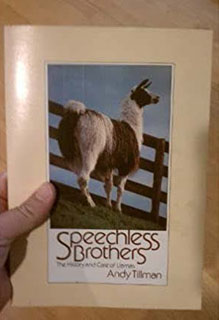Speechless Brothers

Speechless Brothers by Andy Tillman
Book review by Linda Hayes
Prescott Valley, AZ
When I realized that the RMLA library had a copy of Speechless Brothers I decided it was time to read it. It was the very first book on llamas published in North America (1981). At the time, author Andy Tillman was a young whippersnapper who first started raising and packing with llamas in 1975. He has since gone on to be one of the foremost experts on alpaca fleece, noted lama breeder and international authority on llamas and alpacas.
The book covers the history and care of llamas and I was impressed by how much hasn't changed. His advice on training is still solid and the information on vet care, feed, etc. is still useful today. What did make it a fun read was some of the terminology and ideas that have since gone by the wayside. For example, he called male llamas "bulls", which is not the best description of the gentle male llamas we are familiar with today.
Back when the book was written there were very few veterinarians who worked with llamas and there was only a handful of alpacas in the country. Tillman's book was designed to help the newbie raise llamas with confidence. His health advice came from 6 plus years of concentration on llamas, travel to Peru and mentorship by the likes of Dr. William F. Franklin of Iowa State and Dr. Julio Sumar of La Raya High Altitude Research Center in Peru.
I found it interesting to learn where the llama industry was back then. By reading the book I found that the Registry did not exist and that blood testing for DNA was in the future. While his comment that there were no known twin births may have been true in the eighties, since then numerous twins have been documented.
When the book was written, he did not know that alpacas descended from the vicuna and llamas from the guanaco so his chapter on Taxonomy is a bit dated. His description and terminology of wool types was interesting and worth the read.
He makes an interesting observation that I have not seen elsewhere: "If they were born in the fall they will shed in the fall. So don't be upset if your speechless brother begins to shed just as the weather is turning cold, probably means he was born an even number of years ago! As far as I can tell, the llama is the only animal that does this." By this, I believe Mr. Tillman means that they were born 12 months from when they shed for the first time and they will shed on the same month each year after that.
Tillman is the first to use the word "orgle." He apologizes for "not coming up with a less juvenile name...but 'orgle' is what it sounds like." He also said it "sounds like an outboard motor idling in the water".
His training points are practical and I did find his chapter on "Dominance Training" to be intriguing. He recommends teaching llamas to kush as soon as they are halter broken. Most owners have found that llamas use this as a way of saying "no". Current training techniques discourages this behavior.
I found the chapters on packing to be very useful for potential packers to study today. In fact, I would recommend the book to anyone who has llamas. Nearly everything in the book is either interesting to learn or useful to use. It is well written and full of pictures demonstrating his points. For being as old as it is, the book is still worth the read for both for the entertainment value and also for the wealth of useful information. You can buy it on E Bay or borrow it from the RMLA library.
Like this article? Become a RMLA Member today!

